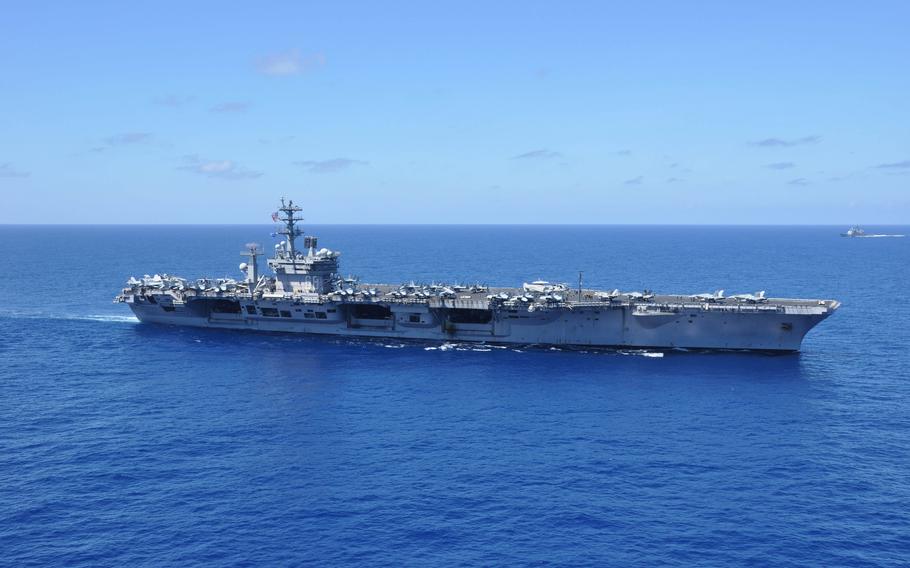
The aircraft carrier USS Nimitz operates in the South China Sea during exercises in 2017. The Navy has issued an $18.4 million contract to begin preliminary planning to deactivate the nuclear power plants on the Nimitz, the first step toward decommissioning the ship. (U.S. Navy )
The Navy has begun the process of retiring its oldest aircraft carrier, the USS Nimitz, which was commissioned in 1975.
Huntington Ingalls Inc. has received an $18.4 million contract from U.S. Naval Sea Systems Command to handle preliminary planning to deactivate the nuclear power plants on the Nimitz, the first step toward decommissioning and eventual disposal.
The contract calls for a deactivation plan to be submitted to the Navy by November 2024. The Nimitz is still on active duty, homeported at Naval Base Kitsap in Washington state, with deactivation planned for 2026 and to be completed in 2027.
The contract for the Nimitz was included in an Aug. 28 roundup of projects approved by the Defense Department. Naval Sea Systems Command will oversee the project.
The Nimitz completed a six-month maintenance at the Puget Sound Naval Shipyard in June and shares a portion of Naval Base Kitsap with the aircraft carrier USS Ronald Reagan.
After the Ronald Reagan completes its six-month overhaul, the ship is scheduled to take up the Nimitz’s role as the Navy carrier homeported in the Pacific Northwest.
The Navy’s plan for the Nimitz calls for it to transit down the West Coast of the United States and South America, around Cape Horn, and proceed to Newport News, Va., where the deactivation work would begin, according to the contract.
The Nimitz is the first of the class of 10 nuclear-powered aircraft carriers based on the same design. It’s named after former five-star admiral Chester Nimitz, a Navy leader in World War II. All Nimitz-class carriers were built between 1968 and 2006 at Newport News Shipbuilding in Virginia.
The Nimitz was the second nuclear-powered aircraft carrier to join the Navy, following the USS Enterprise, a design used for only one ship. The Navy’s newest carrier is the USS John F. Kennedy of the Gerald R. Ford-class. It was commissioned in June 2017.
The John F. Kennedy was planned to replace the Nimitz in the fleet next year, but its delivery date was pushed back by the Pentagon to 2025. Two more Gerald Ford-class ships are under construction — a new USS Enterprise and the USS Doris Miller, which is named after the black sailor who received the Navy Cross for heroism at Pearl Harbor.
The Navy had announced in 2023 that the Nimitz would be retired in 2025, with the second-oldest carrier of the class, the USS Dwight D. Eisenhower, scheduled to retire in 2026.
But the Nimitz deactivation date was pushed back to May 2026 amid delays in the construction of the new Gerald Ford-class carriers.
The deactivation of the Nimitz is also awaiting deconstruction techniques that will be used to take apart the nuclear reactors on the original USS Enterprise, which was deactivated in 2012 and decommissioned in 2017 but has not undergone major demolition work yet.
The Navy has said it also delayed the retirement of the Nimitz and Eisenhower out of heightened demand for carrier strike groups to respond to crises around the globe, including recent tensions in the Red Sea and the Taiwan Strait.
The Navy confirmed earlier this year that it would move ahead with the retirement of the Nimitz, but it now expects Eisenhower to continue in service until at least 2030.
The contract for Huntington Ingalls is earmarked for advanced planning of defueling the Nimitz’s two separate nuclear reactors, which heat water using nuclear fission to crate steam that passes through four turbines. The power plants generate up to 260,000 horsepower, turning four 25-foot diameter bronze propellors, each weighing 66,000 pounds. The Nimitz has a top speed of slightly more than 30 knots.
President Gerald Ford commissioned the Nimitz at Naval Station Norfolk, Va., on May 3, 1975, three days after the fall of Saigon marked the end of the Vietnam War.